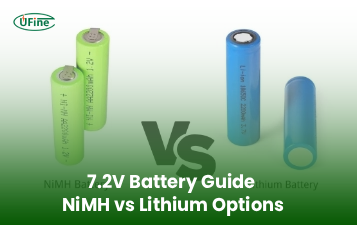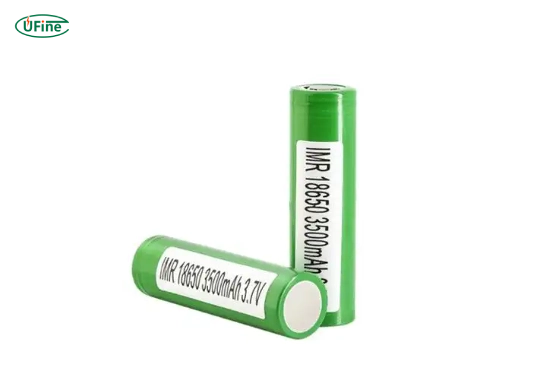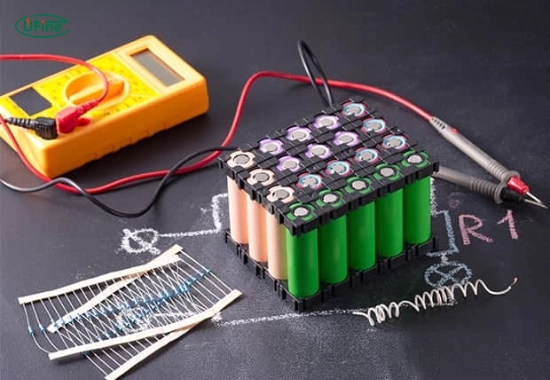
- Part 1. What is an IMR battery?
- Part 2. How does an IMR battery work?
- Part 3. IMR chemistry vs. other lithium-ion batteries
- Part 4. What are IMR batteries used for?
- Part 5. Common IMR battery sizes and specifications
- Part 6. Benefits of using IMR batteries
- Part 7. Safety tips for handling IMR batteries
- Part 8. How to choose the right IMR battery?
- Part 9. IMR battery myths debunked
- Part 10. IMR battery maintenance and lifespan
- Part 11. FAQs about IMR batteries
What is an IMR battery, and why is it the best choice for high-drain applications? An IMR battery is a type of lithium-ion rechargeable battery that uses lithium manganese oxide as its primary cathode material. Known for its high discharge capability, excellent thermal stability, and enhanced safety, it is widely used in devices that require strong bursts of power, such as vapes, power tools, LED flashlights, and some medical equipment.
This in-depth guide will help you understand IMR batteries, from their chemistry and construction to their real-world benefits, so you can choose the right battery for your specific application.
Part 1. What is an IMR battery?
An IMR battery is a rechargeable lithium-ion cell that utilizes lithium manganese oxide (LiMn2O4) in its cathode. The abbreviation “IMR” refers to:
- I for lithium-ion
- M for manganese
- R for rechargeable
These batteries are engineered to handle high load currents efficiently and safely. Unlike other lithium-ion chemistries, IMR cells are more chemically stable and often do not require built-in protective circuitry. This makes them ideal for high-performance applications where safety and reliability are essential.
Part 2. How does an IMR battery work?
IMR batteries allow lithium ions to move between the cathode and anode during charge and discharge cycles. The unique aspect of IMR technology is that it uses manganese oxide, which provides a crystal structure that naturally resists overheating and chemical instability.
This structure leads to:
- High discharge rates suitable for power-hungry devices
- Enhanced thermal stability
- Low internal resistance, which helps with power efficiency
The result is a battery that can deliver continuous high current without compromising on safety or lifespan.
Part 3. IMR chemistry vs. other lithium-ion batteries
Understanding how IMR batteries compare to other lithium-ion chemistries can help you make better purchasing decisions. Below is a detailed comparison based on real data:
| Feature | IMR (LiMn2O4) | ICR (LiCoO2) | INR (LiNiMnCoO2) |
|---|---|---|---|
| Cathode Material | Lithium Manganese Oxide | Lithium Cobalt Oxide | Lithium Nickel Manganese Cobalt |
| Voltage (Nominal) | 3.6V to 3.7V | 3.6V to 3.7V | 3.6V to 3.7V |
| Energy Density | 100 to 130 Wh/kg | 150 to 200 Wh/kg | 150 to 220 Wh/kg |
| Max Discharge Rate | 10C to 30C | 1C to 2C | 5C to 15C |
| Thermal Stability | Excellent | Poor | Good |
| Cycle Life | 300 to 500 cycles | 300 to 500 cycles | 500 to 1000 cycles |
| Safety | Very High | Low | High |
| Use Case | Vapes, tools, LED lights | Laptops, cameras | EVs, power tools, laptops |
Conclusion: IMR batteries may not have the highest energy density, but they are superior in power delivery, safety, and thermal stability.
Part 4. What are IMR batteries used for?
IMR batteries are specifically designed for high-drain electronics. Their ability to safely deliver large currents makes them ideal in various industries:
- Vaping devices: IMR cells are the top choice for mods and e-cigarettes due to their fast and reliable discharge.
- LED flashlights: High-lumen torches require stable, high-current sources.
- Power tools: Drills, saws, and other hand tools need batteries to handle sudden power surges.
- Medical equipment: Devices like portable monitors and defibrillators rely on dependable power.
- RC cars and drones: Quick acceleration and high speeds depend on instant energy delivery.
- Photography gear: Flash units and strobes often demand instant, high-capacity pulses.
These batteries are efficient and safe, even under pressure, making them excellent for consumer and industrial use.
Part 5. Common IMR battery sizes and specifications
IMR batteries are available in various sizes to meet different power requirements. Here’s a breakdown of the most commonly used formats:
| Battery Size | Nominal Voltage | Typical Capacity (mAh) | Max Continuous Discharge (A) |
|---|---|---|---|
| 18350 | 3.7V | 700 to 900 | 10 to 15A |
| 18650 | 3.7V | 1500 to 3000 | 20 to 35A |
| 20700 | 3.7V | 3000 to 4000 | 25 to 40A |
| 21700 | 3.7V | 4000 to 5000 | 30 to 45A |
| 26650 | 3.7V | 4200 to 5500 | 35 to 50A |
Always cross-reference the battery specifications with your device’s requirements to ensure safe and optimal performance.
Part 6. Benefits of using IMR batteries
IMR batteries offer a range of advantages that make them stand out in the lithium-ion family.
High Discharge Capability
IMR cells can deliver rapid and continuous bursts of energy, essential for devices that demand instant power.
Improved Safety
Manganese-based chemistry creates a stable crystal structure that resists overheating and reduces the risk of fire or explosion.
Longer Cycle Life
IMR batteries maintain their performance over 300 to 500 full charge-discharge cycles, making them cost-effective.
Lower Internal Resistance
This feature reduces energy loss and improves efficiency, especially in high-performance tools.
No Need for Built-in Protection
Because of their inherent chemical stability, many IMR batteries can be used safely without a protective circuit board, although it is still recommended in some cases.
Part 7. Safety tips for handling IMR batteries
Even though IMR batteries are safer than many other types, proper handling is crucial. Follow these best practices:
- Always use a charger designed for IMR chemistry
- Avoid overcharging or over-discharging
- Store batteries in dry, cool environments
- Never carry loose batteries in your pocket or bag
- Use battery cases for transport
- Inspect for physical damage before each use
- Never mix old and new batteries in a device
Good battery hygiene ensures safety, performance, and longevity.
Part 8. How to choose the right IMR battery?
Selecting the right IMR battery involves matching your device’s needs with the correct battery specifications. Key considerations include:
- Voltage and Size Compatibility
- Ensure the battery fits physically in your device.
- Confirm the voltage matches your device’s requirements to avoid malfunction.
- Discharge Rate Requirements
- High-drain devices need batteries with high continuous current output.
- Always check the battery’s amp rating to match your device’s needs safely.
- Capacity (mAh)
- Higher capacity provides longer runtime.
- Balance capacity with discharge rate for optimal performance.
- Brand and Reliability
- Stick to reputable brands or certified manufacturers.
- Quality batteries reduce risks of overheating, leakage, or failure.
- Customization Options
- For industrial or special projects, consider custom IMR battery packs.
- Ufine Battery provides tailor-made solutions for specific voltages, sizes, and discharge profiles.
- Their engineering team ensures performance, safety, and compliance with technical standards.
Choosing a custom IMR battery from Ufine ensures precision power delivery, long life, and dependable safety for mission-critical applications.
Part 9. IMR battery myths debunked
Understanding the truth behind battery myths can prevent misuse and improve safety.
Myth 1: All lithium-ion batteries are the same
IMR batteries use a completely different chemistry and are designed for high-drain applications.
Myth 2: IMR batteries never need protection
While safer, some devices still benefit from external protection circuits to prevent damage.
Myth 3: Higher mAh is always better
This is not always true. A higher mAh battery may have a lower discharge rate, which could be unsuitable for power-hungry devices.
Myth 4: Any charger will work
Always use chargers made for IMR chemistry to avoid undercharging or overcharging.
Part 10. IMR battery maintenance and lifespan
Proper care ensures longer battery life and safer use. Here are some maintenance tips:
- Charge before it drops below 3.0V
- Avoid charging beyond 4.2V
- Keep away from extreme heat or cold
- Use smart chargers with auto cut-off
- Store partially charged if unused for long periods
- Rotate batteries if used in pairs or groups
IMR batteries typically last up to 500 full cycles or around 2 to 3 years with good maintenance.
Part 11. FAQs about IMR batteries
Are IMR batteries better than ICR batteries?
Yes. IMR batteries are safer, have higher discharge rates, and are more suitable for high-current applications.
Can I use an IMR battery in any device?
No. Devices must be compatible with high-drain batteries. Always check the manufacturer’s guidelines.
Do IMR batteries explode or catch fire?
Rarely. They are more thermally stable than ICR batteries. However, misuse or low-quality cells may still pose risks.
How long do IMR batteries last?
Depending on usage and care, IMR batteries typically last between 300 and 500 charge cycles.
What charger is best for IMR batteries?
Use only smart lithium-ion chargers compatible with IMR cells. Trusted brands include XTAR, Nitecore, and Efest.
Related Tags:
More Articles

NiMH vs Lithium 7.2V Battery and Charger: Which Is Better?
Compare 7.2V NiMH vs Lithium batteries and chargers in 2025. Learn runtime, weight, charging, lifespan, and cost to choose the best for your device.
How to Choose the Right 7.2V Battery and Charger for Your Device?
Learn how to choose the right 7.2V battery and charger for optimal performance, safety, and longevity across RC, tools, medical, and industrial devices.
Big Square Battery Safety Standards You Must Know
Learn key safety standards for big square batteries to avoid fire risks, shipping delays, and compliance issues in EV, industrial, and energy storage projects.
Big Square Battery Applications in Solar & Industrial Equipment
Big square batteries deliver high capacity, stable output, and long life for solar, industrial, and backup power. Explore key uses and advantages.
Big Square Battery vs Cylindrical Battery: Complete 2025 Guide for EVs, ESS & Industrial Devices
Choosing the right battery is key for designers and engineers. Compare big square vs cylindrical batteries to find the best fit for your application.




